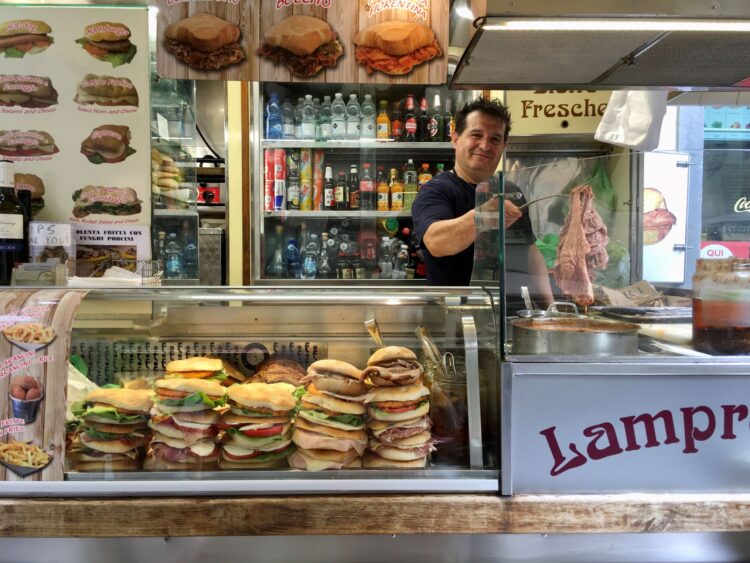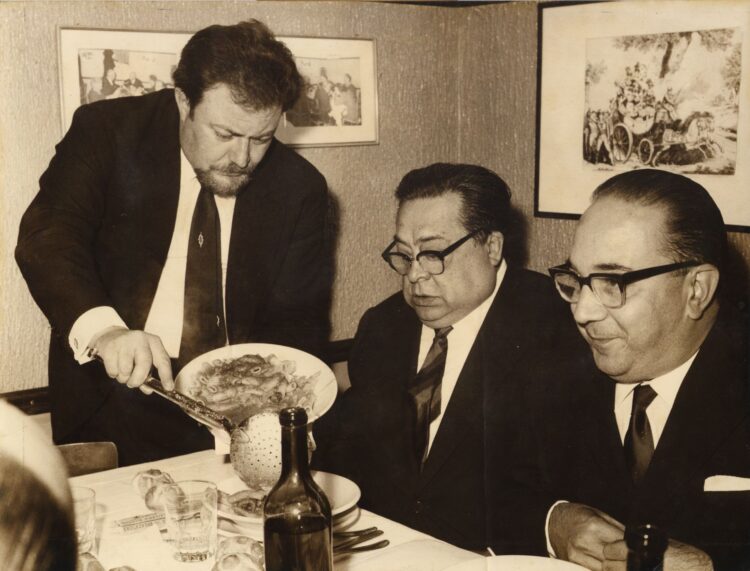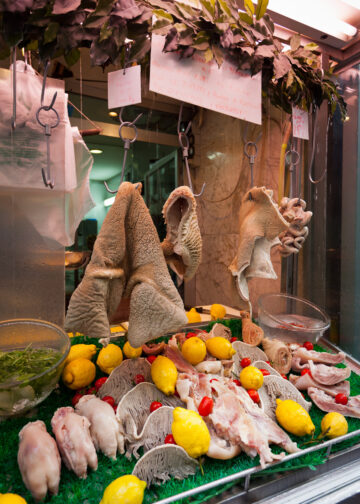Think cucina italiana and you’ll immediately come up with pizza, pasta, tomato sauce, pesto, and gelato. Few foreigners would ever dream that another multi-regional Italian dish is trippa or tripe, inexpensive, often stewed in tomato sauce and topped with grated pecorino (sheep) cheese.
Except for in the United States and Canada, it’s eaten worldwide (especially in France). Nonetheless, although an acquired taste even for Italians, several of the stivale’s cities, Treviso, Turin, Milan, Parma, Bologna, Genoa, Lucca, Florence, Naples, and Ragusa, boast their very own recipes.

To name some examples: in Treviso it’s a soup eaten on market days; in Turin they serve it with mushrooms; in Genoa with beans, peas, and potatoes; in Lucca with cinnamon; in Ragusa with capers, almonds, walnuts, thyme, and cinnamon; and in Naples simply boiled with salt and lemon juice. In fact, no self-respecting Neapolitan crèche would be complete without its ‘o piere e o’ musso (pig’s feet and cow snouts) a seller’s stall decorated with its garland of terracotta lemons. The Romans and the Milanese traditionally eat tripe on Saturdays, but in Milan they call it busecca and other Italians call the Milanese busecconi or tripe eaters. However, busecca is not your ordinary tripe; it comes from la cuppa and la francese, Milanese dialect for “cap” and “the Frenchwoman”. The “cap” is the caul and “the Frenchwoman” is curly tripe.
In Florence, especially in the once working-class neighborhood of San Frediano in the Oltrarno or “Across the Arno”, they too specialize in curly tripe, but they call it lampredotto, the lining of the cow’s last stomach. After a morning seeing the masterpieces in the Pitti Palace and Massaccio and Masolino’s frescoes in the Brancacci Chapel of Santa Maria del Carmine Church, stay in San Frediano to sample the city’s best lampredotto together with the local craftsmen at Trattoria Diladdarno (Via de’ Seragli 108r, 011-39-055-224917, closed Mondays), Vinesio (Borgo San Frediano 145r, 011-055-223449, closed Mondays) or La Casalinga (Via dei Michelozzi 9r, 011-39-055-218624, closed Sundays), three old-fashioned neighborhood trattorie.

Surprise: if you’re short on time, lampredotto is the fast food of Florence. It’s sold, boiling-hot, chopped finely before your eyes, from street carts, and served “classico” with salt and pepper for 4 euros or “complete” with green and/or hot sauce, also on a hard roll the top of which has been dipped in hot broth for 5 euros. Open from around 8:30 a.m. to 7 p.m. weekdays as well as Saturday mornings, mobile tripperie are located at: Loggia del Porcellino, Piazza de’ Cimatori, in the parking lot of Piazza Porta Romana, Via dell Ariento (just outside the Central Market), Via dei Macci (near Santa Croce and the market of Sant’Ambrogio), Lorenzo Nigro in the Central Market, and Via Maso Finiguerra plus Piazza dei Nerli (south of the Amerigo Vespucci bridge).
Maurizio and his brother Roberto Marchetto own the cart in Piazza de’ Cimatori. They are the nephews of Palmiro Pinzuti, nicknamed “Miro”, their cart’s first owner, whom I came to know well because I purposely lunched there every time I went to Florence. “Miro” had emigrated from Calabria some 40 years ago and at first sold lampredotto from his bicycle. On a recent visit Maurizio told me that lampredotto had to boil for at least two hours in vegetable broth and remain in the pot of very hot broth until served. He also told me that his best customers were Chinese, Koreans and Asians in general, whereas the British and South Americans won’t even accept a taste.
As for Rome, the neighborhood for tripe is Testaccio, in ancient times the Eternal City’s port. Testaccio refers to the high hill of broken and discarded potsherds of the terracotta amphora containing grain, olive oil or wine unloaded there. Beginning in the 1880s, soon after the Unification of Italy, the municipal slaughterhouse was located here until it closed in 1975. Its workers were paid in kind with the quinto quarto or fifth quarter, ie. the part of the cow with no bones: offal (heart, lungs, liver, sweetbreads, tripe, and intestines) as well as oxtail.

So, for the best tripe in Rome, head to Checchino dal 1887, today owned and run by the brothers Francesco and Elio, the fifth generation of the Marino family to own Checchino dal 1887 (Via di Monte Testaccio 30, 011-39-065746318, closed Mondays. Nearby at Via Marmorata 39, also worth a stop is Trattoria Perilli, 011-39-065755100.
Farther afield on the Tiber Island at Via Ponte Quattro Capi 16, 011-39-06681601, closed Sundays-Wednesdays, is picturesque Trattoria Sora Lella, founded by Elena Fabrizi, the sister of the comedian Aldo and still run by her family.

A new biography with recipes Annamo bene-la cucina romana di Sora Lella written by her four grandchildren, Mauro, Renato, Simone and Elena Trabalza, who run the trattoria today, with a preface by Carlo Verdone, was just published on October 19th by Giunti (24.90 euros).
Historically-speaking, in Rome there’s an expression “Non c’è trippa per gatti” which literally translates: “There’s no tripe for cats” and metaphorically means both “There’s little hope that you’ll achieve what you want, no matter how hard you try” and “You have to make do with what you have and not expect extras”. Apparently when London-born Ernesto Nathan was mayor of Rome from 1907-13, he cancelled an entry in the municipal budget, which paid for “frattaglie (innards) per gatti”. Nathan crossed it out and wrote in the margin “Non c’è trippa per gatti.” Thus, no more public charity for the city’s ever-increasing cat population!
Personally-speaking: Several years ago, before internet, I wrote a column in an American inflight magazine about the specialties and where to eat them in European cities. The editor sent me a FAX asking: “Do the Romans really eat innards?? When I replied “Yes”, he wrote back: “And do you?”












